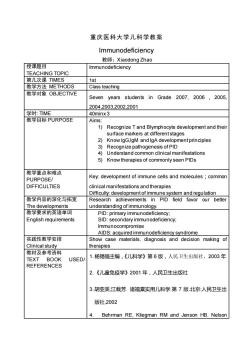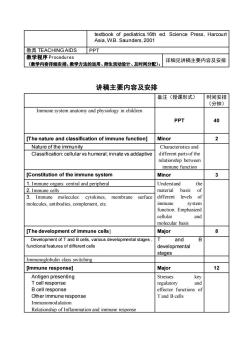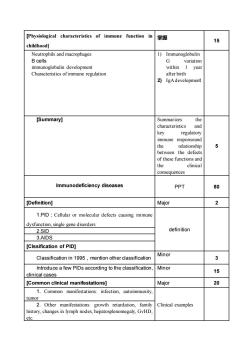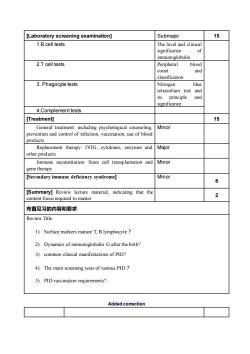《儿科学》课程教学资源(授课教案)13 Immunodeficiency

重庆医科大学儿科学教案Immunodeficiency教师:XiaodongZhao授课题目ImmunodeficiencyTEACHINGTOPIC第几次课TIMES1st教学方法METHODSClass teaching教学对象OBJECTIVEin Grade 2007,2006,2005,Seven years students2004,2003.2002,2001学时:TIME40minx 3教学目标PURPOSEAims:1) Recognize T and Blymphocyte development and theirsurface markers at different stages2) Know IgG,IgM and IgA developmentprinciples3)Recognize pathogenesis of PID4) Understand common clinical manifestations5)KnowtherapiesofcommonlyseenPiDs教学重点和难点Key: development of immune cells and molecules ; commonPURPOSEIclinical manifestations and therapiesDIFFICULTIESDifficulty:development of immune system and regulation教学内容的深化与拓宽Research achievements in PID field favor our betterThe developmentsunderstanding of immunology.教学要求的英语单词PID:primaryimmunodeficiencyEnglish requirementsSID:secondary immunodeficiency:ImmunocompromiseAIDS: acquired immunodeficiency syndrome实践性教学安排Show case materials, diagnosis and decision making ofClinical studytherapies教材及参考资料1.杨锡强主编,《儿科学》第6版,人民卫生出版社,2003年TEXTBOOKUSEDIREFERENCES2.《儿童免疫学》2001年,人民卫生出版社3.胡亚美,江载芳.诸福棠实用儿科学.第7版.北京:人民卫生出版社,2002Behrman RE, Kliegman RM and Jenson HB. Nelson
重庆医科大学儿科学教案 Immunodeficiency 教师:Xiaodong Zhao 授课题目 TEACHING TOPIC Immunodeficiency 第几次课 TIMES 1st 教学方法 METHODS Class teaching 教学对象 OBJECTIVE Seven years students in Grade 2007, 2006 , 2005, 2004,2003,2002,2001 学时: TIME 40minx 3 教学目标 PURPOSE Aims: 1) Recognize T and Blymphocyte development and their surface markers at different stages 2) Know IgG,IgM and IgA development principles 3) Recognize pathogenesis of PID 4) Understand common clinical manifestations 5) Know therapies of commonly seen PIDs 教学重点和难点 PURPOSE/ DIFFICULTIES Key: development of immune cells and molecules;common clinical manifestations and therapies Difficulty: development of immune system and regulation 教学内容的深化与拓宽 The developments Research achievements in PID field favor our better understanding of immunology. 教学要求的英语单词 English requirements PID: primary immunodeficiency; SID: secondary immunodeficiency; Immunocompromise AIDS: acquired immunodeficiency syndrome 实践性教学安排 Clinical study Show case materials, diagnosis and decision making of therapies 教材及参考资料 TEXT BOOK USED/ REFERENCES 1.杨锡强主编,《儿科学》第 6 版,人民卫生出版社,2003 年 2.《儿童免疫学》2001 年,人民卫生出版社 3.胡亚美,江载芳. 诸福棠实用儿科学.第 7 版.北京:人民卫生出 版社,2002 4. Behrman RE, Kliegman RM and Jenson HB. Nelson

textbook of pediatrics.16th ed. Science Press. HarcourtAsia, W.B. Saunders, 2001教具 TEACHINGAIDSPPT教学程序Procedures详细见讲稿主要内容及安排(教学内容详细安排、教学方法的运用、师生活动设计、及时间分配):讲稿主要内容及安排时间安排备注 (授课形式)(分钟)Immune system anatomy and physiology in childrenPPT40[The nature and classification of immune function]Minor2Nature of the immunityCharacteristics andClassification: cellularvs humeral; innate vs addaptivedifferent parts oftherelationship betweenimmune function[Constitution of the immune systemMinor3Immune organs: central and peripheralUnderstandthe2.Immune cellsnaterialbasisodifferentof3.Immune molecules:cytokines,membrane surfacelevelsimmunesystemmolecules, antibod ies, complement, etc.function. Emphasized cellularandmolecular basisMajor8[The development of immune cells]Development of T and B cells, various developmental stagesNTandfunctional features of different cells developmentalstagesImmunoglobulin class switching[mmune response]Major12StresseskaAntigen presentingregulatoryT cell responseeffector functions ofB cell responseT and B cellsOther immune responseImmunomodulationRelationship of Inflammation and immune response
textbook of pediatrics.16th ed. Science Press, Harcourt Asia, W.B. Saunders, 2001 教具 TEACHING AIDS PPT 教学程序 Procedures (教学内容详细安排、教学方法的运用、师生活动设计、及时间分配): 详细见讲稿主要内容及安排 讲稿主要内容及安排 备注(授课形式) 时间安排 (分钟) Immune system anatomy and physiology in children PPT 40 [The nature and classification of immune function] Minor 2 Nature of the immunity Characteristics and different parts of the relationship between immune function Classification: cellular vs humeral; innate vs addaptive [Constitution of the immune system Minor 3 1. Immune organs: central and peripheral Understand the material basis of different levels of immune system function. Emphasized cellular and molecular basis 2. Immune cells 3. Immune molecules: cytokines, membrane surface molecules, antibodies, complement, etc. [The development of immune cells] Major 8 Development of T and B cells, various developmental stages , functional features of different cells T and B developmental stages Immunoglobulin class switching [Immune response] Major 12 Antigen presenting T cell response B cell response Other immune response Immunomodulation Relationship of Inflammation and immune response Stresses key regulatory and effector functions of T and B cells

Physiogicalcharacteristics of immune function in15childhood]Neutrophils and macrophages1) ImmunoglobulinB cellsCvariationimmunoglobulin developmentwithin yearCharacteristics ofimmune regulationafter birth2) IgAdevelopmentSummarizes[Summary]thecharacteristicsandkeyregulatoryimmune responseandrelationshipthebetween the defectsof these functions andtheclinicalconsequencesImmunodeficiency diseasesPPT80[Definition]Major21.PID : Cellular or molecular defects causing immunedysfunction, single gene disordersdefinition2.SID3.AIDS[CIssification of PID]Minor3Classification in 1995 , mention other classificationIntroduce a few PIDs according to the classification,Minor15clinical cases20[Common clinical manifestations]Major1. Common manifestations: infection, autoimmunity,tumor2.Othermanifestations:growthretardation,familyClinicalexampleshistory, changes in lymph nodes, hepatosplenomegaly, GvHD,eto
[Physiological characteristics of immune function in childhood] 掌握 15 Neutrophils and macrophages B cells immunoglobulin development Characteristics of immune regulation 1) Immunoglobulin G variation within 1 year after birth 2) IgA development [Summary] Summarizes the characteristics and key regulatory immune responseand the relationship between the defects of these functions and the clinical consequences 5 Immunodeficiency diseases PPT 80 [Definition] Major 2 1.PID:Cellular or molecular defects causing immune dysfunction,single gene disorders definition 2.SID 3.AIDS [Clssification of PID] Classification in 1995,mention other classification Minor 3 Introduce a few PIDs according to the classification, clinical cases Minor 15 [Common clinical manifestations] Major 20 1. Common manifestations: infection, autoimmunity, tumor 2. Other manifestations: growth retardation, family Clinical examples history, changes in lymph nodes, hepatosplenomegaly, GvHD, etc

[Laboratory screening examination]Submajor15The level and clinical1.B cell testssignificanceoimmunoglobulin2.T cell testsPeripheralblood countandclassificationblue3. Phagocyte tests Nitrogentetrazolium test andits principleandsignificance4.Complement tests15[Treatment]General treatment: including psychological counseling.Minorprevention and control of infection, vaccination, use of bloodproductsReplacement therapy: IVIG, cytokines, enzymes and Majorother productsImmune reconstitution: Stem cell transplantation andMinorgene therapy[Secondary immune deficiency syndrome]Minor8[Summary] Review lecture material, indicating that the2content focus required to master布置见习的内容和要求Review Title:1) Surface markers mature T, B lymphocyte ?2) Dynamics of immunoglobulin G after the birth?3) common clinical manifestations of PID?4) The main screening tests of various PID ?5) PIDvaccination requirements?Added correction
[Laboratory screening examination] Submajor 15 1.B cell tests The level and clinical significance of immunoglobulin 2.T cell tests Peripheral blood count and classification 3. Phagocyte tests Nitrogen blue tetrazolium test and its principle and significance 4.Complement tests [Treatment] 15 General treatment: including psychological counseling, prevention and control of infection, vaccination, use of blood products Minor Replacement therapy: IVIG, cytokines, enzymes and other products Major Immune reconstitution: Stem cell transplantation and gene therapy Minor [Secondary immune deficiency syndrome] Minor 8 [Summary] Review lecture material, indicating that the content focus required to master 2 布置见习的内容和要求 Review Title: 1) Surface markers mature T, B lymphocyte? 2) Dynamics of immunoglobulin G after the birth? 3) common clinical manifestations of PID? 4) The main screening tests of various PID? 5) PID vaccination requirements? Added correction

按次数下载不扣除下载券;
注册用户24小时内重复下载只扣除一次;
顺序:VIP每日次数-->可用次数-->下载券;
- 《儿科学》课程教学资源(授课教案)10 Nutritional Iron Deficiency Anemia.doc
- 《儿科学》课程教学资源(授课教案)15 Growth Hormone Deficiency.doc
- 《儿科学》课程教学资源(授课教案)14 Congenital Hypothyroidism.doc
- 《儿科学》课程教学资源(授课教案)17 Varicella.doc
- 《儿科学》课程教学资源(授课教案)16 Measles.doc
- 《儿科学》课程教学资源(授课教案)19 Tuberculosis Meningitis.doc
- 《儿科学》课程教学资源(授课教案)20 Toxic Bacillary Dysentery.doc
- 《儿科学》课程教学资源(授课教案)21 Chronic Gastritis in Children.doc
- 《儿科学》课程教学资源(授课教案)18 Primary Pulmonary Tuberculosis.doc
- 《儿科学》课程教学资源(授课教案)24 Mumps.doc
- 《儿科学》课程教学资源(授课教案)22 Infantale Diarrhea and Fluid Therapy.doc
- 《儿科学》课程教学资源(授课教案)23 Infantile Hepatitis Syndrome.doc
- 《儿科学》课程教学资源(授课教案)25 Scarlet Fever.doc
- 《儿科学》课程教学资源(授课教案)01 Introduction of Pediatrics.doc
- 《儿科学》课程教学资源(授课教案)04 Neonatal Jaundice.doc
- 《儿科学》课程教学资源(授课教案)05 Neonatal Septicemia.doc
- 《儿科学》课程教学资源(授课教案)02 Growth and Development.doc
- 《儿科学》课程教学资源(授课教案)03 Nutrition During Childhood.doc
- 《儿科学》课程教学资源(授课教案)09 Haematopoiesis and Blood Cell Counts.doc
- 《儿科学》课程教学资源(授课教案)08 Congenital Heart Disease.doc
- 《儿科学》课程教学资源(授课教案)11 Acute Convulsion in Children.doc
- 《儿科学》课程教学资源(授课教案)12 Acute Glomerulonephritis,Nephrotic Syndrome.doc
- 《儿科学》课程作业习题(复习题)08 questions of immune system.doc
- 《儿科学》课程作业习题(复习题)07 questions of urinological system.doc
- 《儿科学》课程作业习题(复习题)09 questions of endocrine disorders.doc
- 《儿科学》课程作业习题(复习题)10 questions of infectious diseases.doc
- 《儿科学》课程作业习题(复习题)06 questions of nervous system.doc
- 《儿科学》课程作业习题(复习题)03 questions of respiratory diseases.doc
- 《儿科学》课程作业习题(复习题)04 questions of circulatory system.doc
- 《儿科学》课程作业习题(复习题)05 questions of blood disorders.doc
- 《儿科学》课程作业习题(复习题)02 questions of neonatal diseases.doc
- 《儿科学》课程作业习题(复习题)01 questions of children healthcare.doc
- 《儿科学》课程作业习题(典型病例)06 nephrotic syndrome-2.doc
- 《儿科学》课程作业习题(典型病例)06 anute nepheritis-1.doc
- 《儿科学》课程作业习题(典型病例)08 diarrhea.doc
- 《儿科学》课程作业习题(典型病例)03 congenital heart disease-VSD.doc
- 《儿科学》课程作业习题(典型病例)04 iron deficiency anemia.doc
- 《儿科学》课程作业习题(典型病例)05 purulent meningitis.doc
- 《儿科学》课程作业习题(典型病例)07 congenital hypothyroidism.doc
- 《儿科学》课程作业习题(典型病例)03 congenital heart disease-TOF.doc
